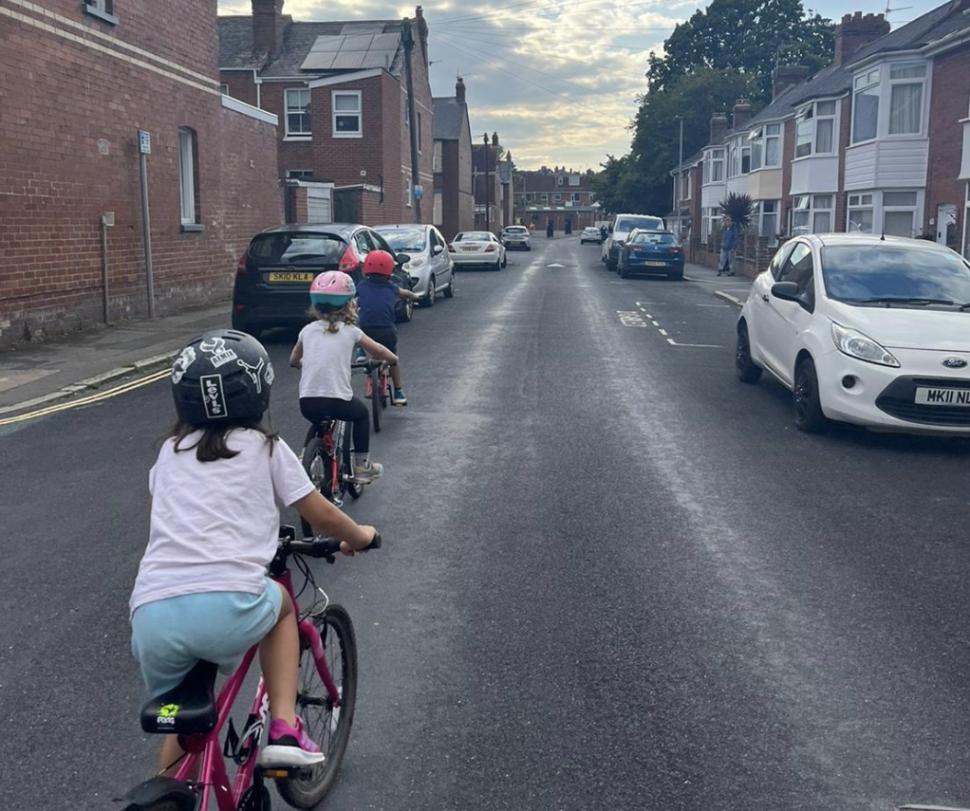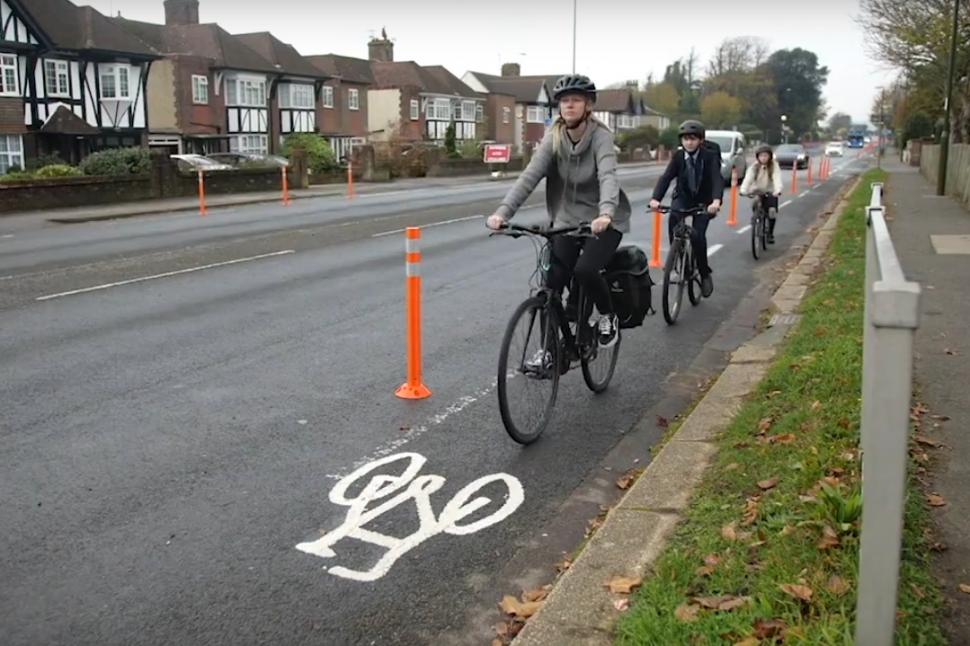- News
- Reviews
- Bikes
- Components
- Bar tape & grips
- Bottom brackets
- Brake & gear cables
- Brake & STI levers
- Brake pads & spares
- Brakes
- Cassettes & freewheels
- Chains
- Chainsets & chainrings
- Derailleurs - front
- Derailleurs - rear
- Forks
- Gear levers & shifters
- Groupsets
- Handlebars & extensions
- Headsets
- Hubs
- Inner tubes
- Pedals
- Quick releases & skewers
- Saddles
- Seatposts
- Stems
- Wheels
- Tyres
- Tubeless valves
- Accessories
- Accessories - misc
- Computer mounts
- Bags
- Bar ends
- Bike bags & cases
- Bottle cages
- Bottles
- Cameras
- Car racks
- Child seats
- Computers
- Glasses
- GPS units
- Helmets
- Lights - front
- Lights - rear
- Lights - sets
- Locks
- Mirrors
- Mudguards
- Racks
- Pumps & CO2 inflators
- Puncture kits
- Reflectives
- Smart watches
- Stands and racks
- Trailers
- Clothing
- Health, fitness and nutrition
- Tools and workshop
- Miscellaneous
- Buyers Guides
- Features
- Forum
- Recommends
- Podcast
news
 Children cycling on Active Travel Street (credit: Exeter Cycling Campaign)
Children cycling on Active Travel Street (credit: Exeter Cycling Campaign)“Don’t leave girls behind”: Calls to address gender gap for children cycling, as new report finds almost twice as many boys ride bikes as girls – and 80% of children want traffic-free routes and pavement parking bans
Sustrans has urged policymakers to tackle the barriers preventing girls from cycling, after the active travel charity’s first ever Children’s Walking and Cycling Index report found that almost twice as many boys regularly ride their bikes as girls.
The new report, which surveyed 1,089 children between the ages of six and 15 across the UK to analyse young people’s travel behaviours and attitudes, revealed that just 17 per cent of girls cycle at least five times a week, a figure that rises to 28 per cent when assessing boys’ cycling habits.
Likewise, only eight per cent of girls surveyed see themselves as “someone who often cycles”, as opposed to 17 per cent of boys.
This disparity, the report found, could be linked to views on safety – when asked whether they thought their local area is a good place to cycle, 66 per cent of girls agreed, compared to 72 per cent of boys, while just 65 per cent of girls believe that the safety in their local area is good, as opposed to 70 per cent of boys.
Other factors, such as gendered approaches to cycling and clothing choices, also come into play. For example, one of the girls surveyed by Sustrans, Lily, a secondary school pupil from Swansea, told the charity that she used to cycle around her neighbourhood and in the local parks, but “grew out of it”.
“I think many girls my age don’t really tend to cycle or use bikes. It's not really seen as cool and we can be quite self-conscious about that,” Lily said.
“I think this is because our clothes don't really allow us, especially if we’re wearing skirts, and it seems a lot of the equipment for cycling is made for men instead of women.”
According to Sustrans, the “worrying” gender gap flagged in the report “means fewer girls are likely to either start or continue cycling as they grow up, depriving them of the benefits cycling brings; improved health, economic and education opportunities, and access to nature.”
Elsewhere in the report, it was found that just 48 per cent of children cycle at least once a week, and that just 14 per cent of all trips are made by bike.
More encouragingly, however, 23 per cent of children cycle five or more times each week, and 51 per cent say they want to cycle more – the highest percentage of any form of transport surveyed.
When taking active travel into account more generally, 55 per cent of children’s journeys are made by walking, wheeling, scooting, or cycling, while 85 per cent of children actively travel at least five times a week.
However, 33 per cent of all journeys are still made by car and van, while 54 per cent of children reported being driven at least five times a week, highlighting their dependency on adults for transport.
Nevertheless, the report makes it clear that children are adamant that the government and local authorities should implement measures to make cycling and walking safer.
81 per cent supported more traffic-free paths and quiet routes for walking and cycling, while 78 per cent agreed that more protected cycle paths should be constructed beside roads and separated from motor traffic.
Meanwhile, 66 per cent backed closing streets to cars during school drop-off and pick-up times, and 70 per cent said they wanted lower speed limits.
Over three-quarters of the children surveyed (76 per cent) also called for measures to prevent motorists from parking their cars on pavements.
More generally, 80 per cent feel it is harder for people to get around without a car, while just under half argued that they don’t feel the government does enough to help people without a car access the things they need to live well.
79 per cent also said they would find it useful if parks, shops, and playgrounds were closer to their home, while just over a quarter agreed that the government was doing enough to tackle climate change.
The report’s findings will be discussed during Sustrans’ Children’s Index Summit in May, which will host representatives from local and central government, along with the active travel sector, as the charity calls for children’s safety and health-based needs to be prioritised when councils are planning transport improvements in their area.
“Children want to cycle and expect our leaders to tackle the barriers stopping them,” Rachel Toms, Sustrans’ Director of Urbanism and UK Programmes, said in a statement.
“We’re asking local and national policymakers to act on children’s enthusiasm for cycling by making sure they invest in more traffic-free and quiet cycle paths so that more children feel safe to get on their bike and get all the lifestyle and health benefits cycling offers.
“Children’s views on transport are too often overlooked by policymakers. We look forward to working with local authorities to improve streets for children, making it safer and more accessible for everyone to get around actively and so we don’t leave girls behind.”
After obtaining a PhD, lecturing, and hosting a history podcast at Queen’s University Belfast, Ryan joined road.cc in December 2021 and since then has kept the site’s readers and listeners informed and enthralled (well at least occasionally) on news, the live blog, and the road.cc Podcast. After boarding a wrong bus at the world championships and ruining a good pair of jeans at the cyclocross, he now serves as road.cc’s senior news writer. Before his foray into cycling journalism, he wallowed in the equally pitiless world of academia, where he wrote a book about Victorian politics and droned on about cycling and bikes to classes of bored students (while taking every chance he could get to talk about cycling in print or on the radio). He can be found riding his bike very slowly around the narrow, scenic country lanes of Co. Down.
Latest Comments
- quiff 26 min 54 sec ago
Less academic, but memorably encapsulated recently by Saoirse Ronan
- quiff 38 min 20 sec ago
Fascinating - I have always thought Hersheys has a whiff of vomit about it!
- Global Nomad 39 min 19 sec ago
good to see you're testing the farsports wheels - hope to see road.cc continue to expand the range of brands it considers. These or the shallower...
- chrisonabike 41 min 51 sec ago
Duly triggered! (At least "it's comedy!" though)....
- quiff 43 min 17 sec ago
Agreed, though those in thrall to the car lease would probably think the same of my coffee expenditure...
- chrisonabike 44 min 59 sec ago
Frustratingly we could probably avoid (most of) this if only one or two fundamental things were the other way around e.g. "you can only drive on...
- chrisotherwise 1 hour 12 min ago
Sadly very normal. And the sand contains loads of evil little shards of flint.
- David9694 4 hours 21 min ago
Random driver account: "cyclists should be made to wear hi viz like workers do on a building site"....
- quiff 4 hours 34 min ago
"The algorithm" served me an older JV video last week which I now can't get out of my head....

Add new comment
4 comments
another reason why uk cycling infrastructure is terrible. It doesn't take gender into account. Women feel far more vulnerable in public spaces than men. So any cycle infrastructure that goes along things like canal towpaths, full of blind spots, hiding places and unlit isolated areas, is not going to facilitate women to frequently cycle
Completely agree. (Not a woman so this is just my take).
Social safety in active travel is not something new. However the whole "social" dimension to it (and in particular social cycling) has long been ditched in favour of the vast amount of space we have taken to allow convenient, almost unrestricted driving and parking everywhere.
What bothers me is we're still building this stuff (at least round Edinburgh) - or at best "look-a-like" things which have lots of people outside of cars, but only in the prospectus. e.g. "oh - look they've put a cycle path in" (shared use, stops at every little side road).
Despite the current ideas around "wokery" it seems we're barely any further along in terms of social safety than back in my youth.
In fact I'd say that things have just shifted around. We've mobiles which might make you feel safer, but equally might facilitate stalking / unwanted attention right in your home.
We now hear a lot about sexual harrassment and assault - but that doesn't seem to be decreasing the incidence of this behaviour.
My understanding is their is evidence that 2 best ways to measure cycling infra quality are to look at usage by minorities and usage by women.
Basically if it's any good it will be used proportional to population. If it's bad it will only be used by white men (in mostly white western countries)...
Superior to most other methods because it isn't affected by weather etc - because that has an equal effect on discouraging different groups... You can measure improvement from day a (20c dry summers day) and day b (1c horizontal torrential rain) despite 50+% deciding they can cycle when the weather is better...
Truth to that. It captures social safety also. (Caveat that we have also made driving incredibly cheap and easy - where it's easy to drive, Brits drive...)
Obviously this is a crude metric - so in some places in the UK you'll find "minorities" using the infra, because that's who the
responsibility-offloadingjob-creating food delivery firms largely have asemployeespartners.I don't think it's a coincidence though that in places which actually provide for cycling across e.g. Europe you see all kinds of everyone riding, dressed in normal clothes, often not wearing helmets or other PPE. But not so much in the UK.